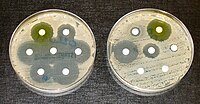
Photo from wikipedia
We sought to evaluate time for bacterial culture and initiation of appropriate therapy for patients, from 2017 (without rapid diagnostic test (RDT) and Antimicrobial Stewardship Program (ASP)) and 2018 (with… Click to show full abstract
We sought to evaluate time for bacterial culture and initiation of appropriate therapy for patients, from 2017 (without rapid diagnostic test (RDT) and Antimicrobial Stewardship Program (ASP)) and 2018 (with RDT and ASP). Time to identification (ID) was significantly faster in 2018 (2018 24.9 ± 14.4, 2017 33.8 ± 17 h, P = 0.001). Time to antimicrobial susceptibility test (AST) results was significantly faster for patients in 2018 compared to 2017 (18.2 ± 14 h compared to 28.5 ± 14.9 h, P < 0.001). Length of hospital stay for enrolled patients was significantly shorter in 2018 compared to 2017 (2018 10.7 ± 11.1 days and 2017 15.5 ± 18.1 days, P = 0.05). Length of antimicrobial therapy for enrolled patients was significantly shorter for 2018 (2018 6.7 ± 3.8 d vs. 2017 8.8 ± 7.8 d, P = 0.036). These results demonstrate MALDI-TOF/Vitek 2 leads to an average 21.5 h faster ID and AST results that can be acted upon by ASP for antimicrobial recommendations.
Journal Title: Diagnostic microbiology and infectious disease
Year Published: 2019
Link to full text (if available)
Share on Social Media: Sign Up to like & get
recommendations!